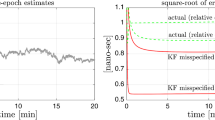Abstract
A new approach to the optimal adaptive filtering is proposed in this paper. In this approach, a polynomial prediction model is used to describe the time-variant/invariant impulse response coefficients of an identified system. When the polynomial prediction model is viewed as the state equations of the identified impulse response coefficients and the relationships between the inputs and outputs of the system are regarded as the measurements of the states, our adaptive filtering can be achieved in the framework of the Kalman filter. It is understood that Kalman filter is optimal in the sense of the MAP (maximum a posteriori), ML (most likelihood) and MMSE (minimum mean square error) under the linear and Gaussian white noise conditions. As a result, our algorithm is also optimal in the statistical senses as Kalman filter does, provided that the impulse response coefficients can be modeled by a polynomial. Not only do the analytical results of the algorithm but also the simulation results show that our algorithm outperforms the traditional known algorithms.
Similar content being viewed by others
References
Widrow B, Stearns S D. Adaptive Signal Processing. Englewood Cliffs, NJ: Prentice-Hall, 1985
Haykin S. Adaptive Filter Theory. 4th ed. Upper Saddle River, NJ: Prentice-Hall, 2002
Benesty J, Huang Y. Adaptive Signal Processing—Applications to Real-World Problems. Berlin: Springer-Verlag, 2003
Huang Y, Benesty J, Chen J. Acoustic MIMO Signal Processing. Boston, MA: Springer, 2006
Sayed A H. Fundamentals of Adaptive Filtering. New York: Wiley, 2003
Glentis G O, Berberidis K, Theodoridis S. Efficient least squares adaptive algorithms for FIR transversal filtering. IEEE Signal Process Mag, 1999, 16: 13–41.
Guo L, Ljung L, Wang G J. Necessary and suffcient conditions for stability of LMS. IEEE Trans Automat Control, 1997, 42: 761–770
Hassibi B, Sayed A H, Kailath T. H 8 optimality of the LMS algorithm. IEEE Trans Signal Process, 1996, 44: 267–280
Evans J B, Xue P, Liu B. Analysis and implementation of variable step size adaptive algorithms. IEEE Trans Signal Process, 1993, 41: 2517–2535
Aboulnasr T, Mayyas K. A robust variable step-size LMS-type algorithm: analysis and simulations. IEEE Trans Signal Process, 1997, 45: 631–639
Pazaitis D I, Constantinides A G. A novel kurtosis driven variable step-size adaptive algorithm. IEEE Trans Signal Process, 1999, 47: 864–872
Mader A, Puder H, Schmidt G U. Step-size control for acoustic echo cancellation filters-an overview. Signal Process, 2000, 80: 1697–1719
Morgan D R, Kratzer S G. On a class of computationally efficient, rapidly converging, generalized NLMS algorithm. IEEE Signal Process Lett, 1996, 3: 245–247.
Gollamudi S, Nagaraj S, Kapoor S, et al. Set-member-ship filtering and a set-membership normalized LMS algorithm with an adaptive step size. IEEE Signal Process Lett, 1998, 5: 111–114
Shin H C, Sayed A H, Song W J. Variable step-size NLMS and affine projection algorithms. IEEE Signal Process Lett, 2004, 11: 132–135
Benesty J, Rey H, Vega L R, et al. A nonparametric VSS NLMS algorithm. IEEE Signal Process Lett, 2006, 13: 581–584
Gendron P J. An empirical Bayes estimator for in-scale adaptive filtering. IEEE Trans Signal Process, 2005, 53: 1670–1683
Huang D Y, Rahardja S, Huang H B. Maximum a posteriori based adaptive algorithms. In: Asilomar Conference on Signals, Systems and Computers, Asilomar, 2007. 1628–1632
Steven M K. Fundamentals of Statistical Signal Processing, Volume: Estimation Theory; Fundamentals of Statistical Signal Processing, Volume: Detection Theory (in Chinese). Beijing: Publishing House of Electronics Industry, 2003
van der Merwe R. Sigma-point Kalman filters for probabilistic inference in dyanmic state-space models. Dissertation for the Doctoral Degree. Cape Town, South Africa: Oregon Health & Science University, 2004
Welch G, Bishop G. An Introduction to the Kalman Filter. http://www.cs.unc.edu/~welch/kalman/kalmanIntro.htm/. 2004.
Weisstein E W. Weierstrass Approximation Theorem. From MathWorld-A Wolfram Web Resource. http://mathworld.wolfram.com/WeierstrassApproximationTheorem.html
Xu L J, Zhang J Q, Yan Y. A wavelet-based multisensor data fusion algorithm. IEEE Trans Instrum Measur, 2004, 53: 1539–1545
Ifeachor E C, Jervis B W. Digital Signal Processing A Practical Approach. 2nd ed. Beijing: Publishing House of Electronics Industry, 2003
Heinonen P, Neuvo Y. FIR-median hybrid filters with predictive FIR substructures. IEEE Trans Acoust Speech Signal Process, 1988, 36: 892–899
Fitzgerald R J. Divergence of the Kalman filter. IEEE Trans Autom Control, 1971, 16: 736–747
Zhang J K. Linear Model Parameter Estimation and Its Improvement. Changsha: Publishing House of National University of Defense Technology, 1999
Chui C K, Cheng G. Kalman Filtering with Real-Time Application. Berlin: Springer-Verlag, 1987
William F, Arnold III, Laub A J. Generalized eigenproblem algorithms and software for algebraic Riccati equations. Proc IEEE, 1984, 72: 1746–1754
Author information
Authors and Affiliations
Corresponding author
Rights and permissions
About this article
Cite this article
Tan, J., Zhang, J. An optimal adaptive filtering algorithm with a polynomial prediction model. Sci. China Inf. Sci. 54, 153–162 (2011). https://doi.org/10.1007/s11432-010-4141-3
Received:
Accepted:
Published:
Issue Date:
DOI: https://doi.org/10.1007/s11432-010-4141-3




